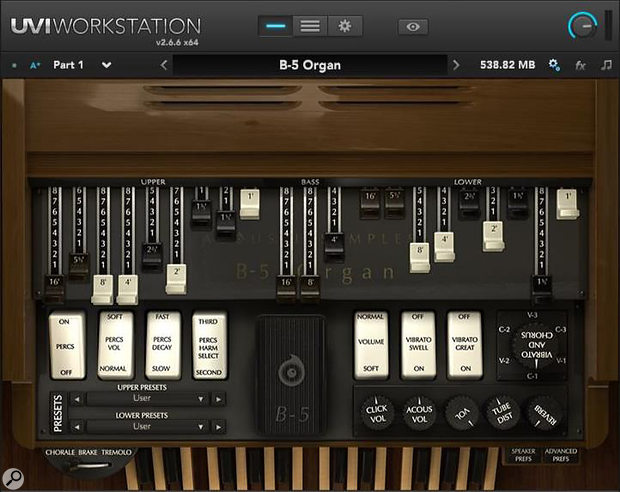Acousticsamples’ B5 Hammond organ VST runs on UVI’s Workstation player. Although based on samples, B5 utilises clever synthesis tricks to overcome the ‘sample stacking’ phase-cancellation artifacts typically associated with sample-based virtual organs. All the crucial elements of a Hammond are reproduced: upper and lower manuals, pedals, drawbars, percussion, key click, scanner chorus/vibrato, tube distortion, rotary effect and more.
B5’s major twist, however, is the extent to which you can customise the instrument, in much the same way that Hammond owners ‘mod’ their instruments. The overall character of the organ can be shaped by fine-tuning the volume range of each drawbar (rather like adding virtual resistance wires), and even altering the distance of each of the 91 ‘tonewheels’ from the pickups. For players that don’t use a pedalboard, the drawbars’ ‘foldback’ can be disabled, allowing the bass tone to be assigned to either or both manuals. The pedals’ optional ‘string bass’ mode adds a variable release time, helping to smooth out bass lines.
The Percussion section is also highly customisable; normal and soft levels are adjustable to personal taste, as are fast and slow decay times. It’s also possible to set the 2nd and 3rd percussion pitches to any of the nine drawbar pitches. When percussion is engaged on a real Hammond, the ninth drawbar is stolen for the purpose. On B5, you can choose which drawbar is stolen — or even choose to have none stolen at all. You can also opt to defeat the drawbars’ volume drop when using the Normal tab. A ‘Paradise’ button, when engaged, prevents the percussion from decaying to silence (a nod to Jimmy Smith) and, rounding off this section, the percussion’s recharge time is also adjustable — very useful for bringing clarity to fast note repetitions.
Essential to any Hammond emulation, B5’s rotary speaker effect offers seven different modelled Leslie cabinets; 25 different (non-rotary) amp/speaker models are also provided as alternatives to the rotary cabinet. The entire speaker emulation can also be bypassed, providing the opportunity to send B5 through an external rotary effect plug-in. B5’s rotary cabinet offers separate adjustments for horn/drum levels, fast and slow speeds, pitch mod depth, air, and distance, the latter being extremely subtle; I found it only really noticeable on headphones. Fast/slow acceleration/deceleration times are fixed, but well-chosen. The horn and drum mics can also be individually set to mono or stereo, with a fixed-frequency three-band EQ following up the rear. Sonically, B5’s Leslie has a distinctly off-mic character, arguably more suited to jazz than rock. I felt the effect could do with a more pronounced volume/timbral modulation, especially on the tremolo setting, which lacks the characteristic ‘rattle’ of the real thing. Frequency separation between the horn and drum is also problematic; too many upper frequencies are clearly present in the drum — the ninth (1’) drawbar in particular should be barely discernible.
Despite those criticisms, the actual organ model is extremely accurate and authentic; the effectiveness of the rotary simulation is subjective, and a matter of personal taste.

